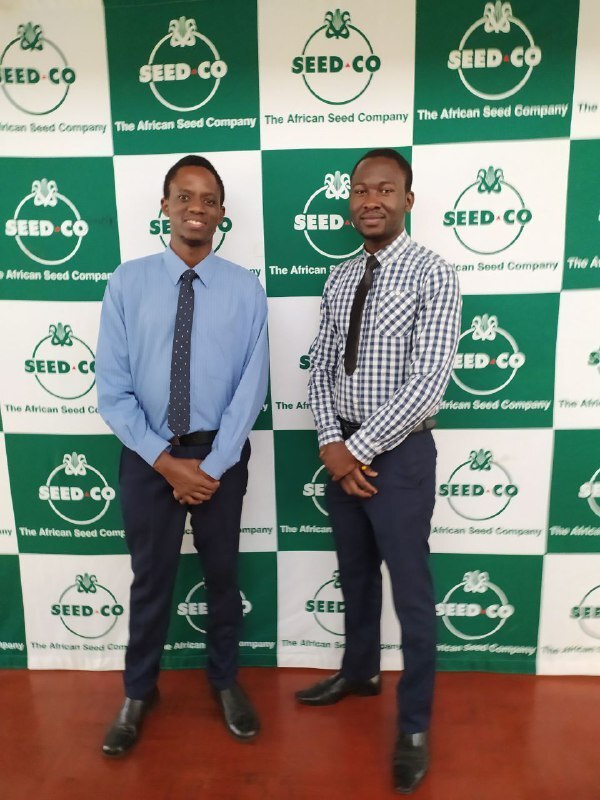Success, Preparation, and why these two words love each other.

They say success comes when preparation meets opportunity. Some like to call this phenomenon using a very strange word - luck. Let's talk more about this.
I (My real name is Chiratidzo by the way), together with a good friend of mine, Steve, became the First Runners Up in the SeedCo Innovation challenge. Have a look at an excerpt from the herald (for the full article, click this link)
Fadziso Mundawarara Herald Reporter
SEED Co, in partnership with Boost Fellowship, shelled out over US$2 500 to motivative students who come up with new agricultural concepts.
The ceremony was held at Seed Co plant in Stapleford, north of Harare, last Friday [20 March].
Seed Co regional managing director Mr Denias Zaranyika said innovation was key, and had become the lifeblood of organisations across the globe.
“Evolutionary and revolutionary innovations are coming in to disrupt the status core. Digital systems have brought a new breath of fresh air to the world, and innovation hubs across the world everyday are dreaming of new and better ways of meeting customer needs and expectations,” he said.
Students who made presentations were each awarded US$300 and WiFi routers.
Ronald Murove from the Midlands State University (MSU) came out tops and bagged US$1 000 while second position went to the duo of Chiratidzo Charakupa and Steve Tadzoka from the Harare Institute of Technology (HIT), who pocketed US$700.
The third prize of US$500 went to Prince Mazimuku from Lupane State University.
Seed Co deputy managing director Dr Edworks Mhandu challenged youths to create solutions for problems and bring creative ideas.
In this article, I made a long analysis of what led to us becoming successful.
What was the competition for? And What did we need to do?
Seed Co Zimbabwe, a company registered to operate in Zimbabwe with a mandate to breed, produce, process and market hybrid crop seeds in partnership with BOOST Fellowship sought to enhance the capacities of young people in Universities and Colleges of Agriculture in developing innovative and technological ideas that would create value for the company as well as improve farmers livelihoods in Zimbabwe. Seed Co was looking for ideas or concepts which could be developed into solutions. Once the ideas had been generated, they would be selected and developed into actionable solutions by the idea generators. The challenge wass open to all University and Agricultural College students from first year up to PhD level.
Concept ideas could include, but were not limited to:
- New technologies and business models that would make agribusiness more inclusive or use collaborative solutions to improve market penetration.
- Innovations that would empower Seed Co farmers to fully participate in agribusiness and gain revenue from employment or entrepreneurship such as new distribution channels
- Initiatives that would lead to new products that are bankable and meet the client needs of Seed Co farmers.
- Marketing, production, social impact or technological ideas which would lead to new products, improved business practices, profitability and potential improvement in production, quality and overall products in the Seed Co stable.
- The winners would be given the opportunity to further develop the proposal for implementation with the full backing from Seed Co, for a period of 6 months. (Maximum 3 people on a team)
Solutions or Ideas were supposed to focus on adding value to Rural Farmers, Commercial Farmers, Seed Producers, Seed Research Communities, Seed houses (SeedCo), Farmer groups and Farmer organisations, Schools (Agriculture), Universities and Colleges
Ideas and proposed solutions could be around these areas in agriculture. Customer Loyalty, Sales, Logistics, Seed research, Weather, Agronomy, Marketing, Breeding, Farm
Activities, Financial reporting, Retail networking, Warehousing, Procurement, Seed Processing, Collaboration and Communication, Seed Quality Assurance and Product development.
What approach did we take?
Brainstorm. Research. Iterate.
We came up with crazy ideas. We found the most suitable one – a system that minimizes post-harvest losses for farmers! We did our research. We found out that there are companies that offer such similar systems, and we had to find our point of differentiation. Our main selling point was the use of complex algorithms that minimize post-harvest losses to an absolute minimum.
We then filled in a google form, making sure that we filled in EVERYTHING in as much detail as possible.
We then saved a backup copy – just in case we were chosen to present, and boy did that come in handy.
What was the most challenging part of getting it done?
The application phase. It’s very easy to say – hey that’s not for me! Let’s just leave it. I was by HIT (the Harare Institute of Technology) this linkwhich is a university in which we always have loads of courses so finding time to do the research and all with my team mate was very challenging.
What did number one do different?
He had a killer PPT. He had a killer system. He had a killer presentation. He had a hell of a lot more experience than we did.
What did we learn?
Preparations
#0. We were ready. We consistently scouted for hackathons and competitions. Once we found any, we would choose a nice, quiet place to discuss in great detail how we would approach the challenge, and what would make us different from the rest.
#1. If you want to go fast, go alone. If you want to go fast, go together.
#2. Choose a great team mate who complements your strengths. And most importantly, discuss everything before hand. What if we win? Who gets how much? Because you will win, and you will fight, and you will lose a friend. And the friend you’ve lost would have run away with all the money.
BONUS TIP. If a person is selfish, stay away from them from them. Rather do it alone. At least you won’t get shortchanged.
#3. When given the opportunity to fill in a Google form for a challenge, don’t be lazy. Type your responses in Word. Remove the ambiguity, and type them again. Look for errors, and type it again ensuring that your intended audience gets the message in the best possible format.
The judges actually said that the depth of content was one of the factors they used in considering the top ten applications. Imagine what would have happened if we were lazy!
#4. Choose your friends very wisely. One thing few people know is how hard it is to celebrate your success with friends who are envious of you. I have a really small circle of friends so celebrating with them wasn’t hard – and I wasn’t scared that they were jealous.
#5. Have a wish list and an if-i-get-money-list. We got cash and in my case, I had a very good plan for the amount. I knew exactly what to invest in, what items of value to buy, how much to share with friends and family (I used percentages in this case), and how much to SPEND. TRUST ME. IT IS VERY EASY TO BLOW ALL THE MONEY IN YOUR CARD. THE MORE, THE EASIER!
#6. Actually believe you will win. During presentation preparations, we knew that the guy who eventually became #1 had a killer system. Even though, we believed that we would be the winners. We had the courage to say WE CAN DO IT!
During presentations preparations
We decided to be different. We didn’t want to bore our audience to death so we used a story. We created a fictitious character, Sekai, and through the story, we brought out the problem. We used a PPT with high quality pictures to show the solution, and to explain our system.
In addition, we practiced. We talked to ourselves. And talked even more. We noted where we make mistakes and took relevant actions such as eliminating tongue twisters, and everything that the investor doesn’t, and shouldn’t care about.
Learning point! NOBODY cares about the technology you use or the code you use or the ingredients you bake… All the investor cares about is:
- Is it feasible?
- Are you the right person to execute the problem?
- Do you have experience?
- How much time will it take you?
- How much money will you make for me?
We knew all this so that’s why we made a good presentation.
During presentations
Wear something comfortable. I don’t like suits. I can tolerate shirts. Other teams wore immaculate suits. That’s them. I’m okay with wearing a loose shirt + tie (I couldn’t use a tee + jeans like I’m used to so that was the second best alternative J ). I was comfortable so it worked. The audience felt it.
TECHNOLOGY MAY FAIL YOU. I had a backup notecard in my pocket. If the PPT failed, I would have gone on as if nothing happened. You need such confidence in a presentation.
NO COMMUNICATION 1 HOUR BEFORE THE PRESENTATION. Why did we put our phones on flight mode an hour before the presentation? Because we didn’t want anything to ruin our mood.
After presentations
Take pics and send them to your family. They will be super excited.

When you get your money
GO HOME. Turn your phones off.
THINK. Give yourself 30 minutes to think how to give the money.
Here’s how I do it. Let’s say there’s 1000 ( I chose this because this is an easy figure to deal with). I would invest 500 for the future.
SPLIT THE REMAINING 500 BETWEEN – DONATIONS TO FAMILY + FRIENDS AND SPENDING FOR ME
That formula (split half, then split the other half between myself + donations) worked quite well for me. If there are better formulas then please do share with me.
Then refer to your wishlist. If you don’t have a wish list, then you’ll probably regret it.
When Spending your money
You need a sober minded person with you. This is your financial advisor (or mini – financial advisor). His/her job is to knock sense into your head.
Here are a few examples of useless things I wanted to buy:
- I wanted to buy [more 9 pack] tissues.
- And I was tempted to buy counter books that I’m given for free at work.
- I wanted to buy a mat.
- I wanted to buy another basket.
Bonus Notes: This wasn’t the first challenge that we had entered as a team.
Me + Steve had entered:
The One Money - Telone Hackathon. We had a brilliant team with brilliant ideas but we FAILED to tell the judges what exactly we were doing.
Lesson Learnt - We got lost in our technical jargon.
Zimnat Innovation Challenge. This was a disaster. We were sooooo late, and we made the PPT 30 minutes before going to pitch to investors.
Lesson Learnt – Do not create your PPT 30 minutes before going to pitch to potential investors.
Well that’s about it. Next week is going to be super productive! I have an awesome project that I would love YOU to be a part of!
Feel free to head over to my social media handles. Drop a message :)
Instagram @ maputiatota, Twitter @ maputiatota
Also, check out the Startup that Steve an I are a part of (it's called Kelteve Distinction Technologies) Just click the link below to visit the site.
Comments